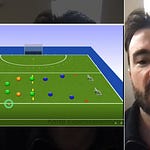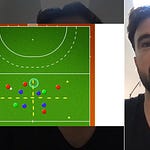We’ve just wrapped up our sixth workshop with Robert Noall. This time we talk about “On-Ball Decision Making,” and it’s safe to say this one’s an absolute must-watch for field hockey coaches. If you missed the live session, this recap’s got you covered—and trust us, you’ll want to dive into the full replay after catching these highlights!
The Theme: On-Ball Decision Making
This session tackled one of the most critical yet underestimated areas of our game: the decisions players make while they’re on the ball. We all harp on about “prescanning” and vision, but what happens in that split-second when the ball’s on the stick? How do players adapt when their pre-planned option disappears, or the game’s speed leaves them improvising on the fly?
Key Takeaways
Here’s what stood out—ready to supercharge your next training?
1. The Two Phases: Prescanning vs. On-Ball Decision Making Everyone’s obsessed with prescanning (and rightly so), but Robert hammered home the need to separate and specifically train what happens after that first scan. The ball’s traveling—prescanning zone. The ball’s received—now enters the on-ball decision phase. Both deserve attention, but each has its own skillset.
2. Body Position, Ball Position, Footwork: Non-Negotiables Robert dissected clips where technically correct decisions went awry solely due to slow feet or poor body positioning. His advice: “If your receiving and footwork aren’t sharp, the right option shuts before you can execute. Drills must demand speed and precision—not just ‘decision drills’ for decision’s sake.”
3. The Art of Changing Decisions As game situations shift, the willingness (and technical ability) to “abort mission” and pick another option is what separates the good from the elite. Robert’s golden rule: “Don’t marry your prescan. React to the now, and don’t be afraid to change your mind.”
4. Contextualized Drills—Not the Same-Old a-b-c-d Hockey He’s allergic to “pass to the right for five minutes, then to the left for five minutes.” Instead, Robert prescribes open-ended scenarios—even in foundational drills—so players make real choices, not follow a script.
5. Early Success for Younger Players When working with U8s and U10s, make the chance of success laughably high—six attackers, two defenders, wide spaces, and heaps of positive feedback. “Let them taste creative freedom while building their confidence to make (and own) decisions. Ramp up difficulty later.”
6. Praise the Decision, Not the Outcome One for your coach’s notebook: keep reinforcing good intent, even if execution fails. “Great decision, unlucky this time—next time it comes off!” This builds a culture where players aren’t afraid to try their best options.
TL;DR: Workshop Lessons
Robert’s message? Decisions aren’t just tactical—they’re technical, psychological, and, most importantly, trainable. To raise intelligent, adaptable players, create sessions overflowing with real choices, positivity for intent, and freedom to try (and sometimes fail).
If you want your players to handle the chaos of real match-play—not just run their lines—this session’s your new blueprint.
Watch It Now
Ready for more? The full masterclass, loaded with video breakdowns, interactive exercises, and audience Q&A, is available to stream now for our pais subcribers. Whether you’re hunting fresh training ideas or rethinking your coaching philosophy, hit the link and immerse yourself in Robert’s pragmatic approach.
Let’s keep building smarter hockey, one decision at a time!
Below, for our paid subscribers, we’ll unpack the major topics explored, delve into the rich Q&A, and close with practical takeaways every coach can immediately apply.













